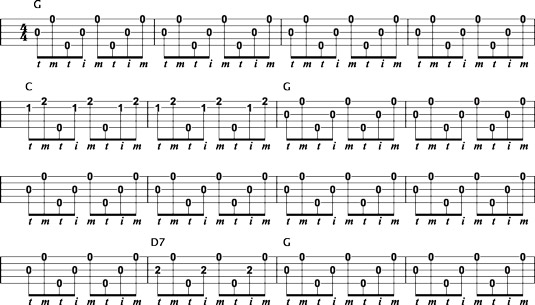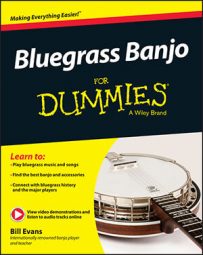Forward rolls put the drive and power into the sound of bluegrass banjo. You simply can’t have cornfield cred without knowing your forward rolls backward and, yes, forward. Forward rolls come in several varieties, with different sequences of picking‐hand fingers. However, at some point in every eight‐note forward roll, you pick two thumb–index–middle sequences that provide the propulsion needed for forward roll liftoff.
Let’s get started by trying out a couple of straightforward examples that emphasize the T–I–M‐ness that’s at the heart of the forward roll:
Forward roll 1
Picking‐hand finger sequence: T–I–M–T–I–M–T–M
String sequence: 3–2–1–3–2–1–3–1
Forward roll 2: All roll patterns sound better with the fifth string added, so now try this different string sequence, using the same picking‐hand sequence as in forward roll 1:
New string sequence: 3–2–1–5–2–1–5–1
 Forward rolls 1 and 2.
Forward rolls 1 and 2.
Forward rolls 1 and 2 begin with two three‐note groupings of T–I–M and conclude with one two‐note grouping of T–M. This sequence gives you the eight notes needed to fill a measure. You can create new forward rolls by changing the order of these two‐ and three‐note groupings:
Forward roll 3: Try taking the two‐note group that was at the end of forward rolls 1 and 2 and move these notes to the beginning of a new forward roll. Then follow those first two notes with the two three‐note T–I–M groupings. Here’s an especially powerful sequence of strings and picking‐hand fingers using this way of playing a forward roll:
Picking‐hand finger sequence: T–M–T–I–M–T–I–M
String sequence: 3–1–5–3–1–5–3–1
Forward roll 4: Try a new string sequence that still uses the same picking‐hand sequence:
String sequence: 2–1–5–2–1–5–2–1
 Forward rolls 3 and 4.
Forward rolls 3 and 4.
Forward roll 4 sounds great when fretting a C chord because you’re now picking two of the three strings that you’re fretting.
Forward rolls are fantastic choices to use to accompany songs because they create rhythmic drive. Try forward rolls 3 and 4 for “Will the Circle Be Unbroken,” moving from roll 3 for the G and D7 chords to roll 4 for the C chord.

It’s a great idea to begin your forward rolls with the picking‐hand thumb whenever possible. The act of using the thumb, instead of the index finger, for the first beat of a measure will help you to feel the downbeat of each new measure more powerfully.
Because chord changes commonly occur on downbeats, you’re also helping yourself remember the chord progression when moving your thumb to play that first note of a new chord. Putting the thumb to it, as they say down in North Carolina, is one of Earl Scruggs’s most important innovations, which is reason enough to try it!

